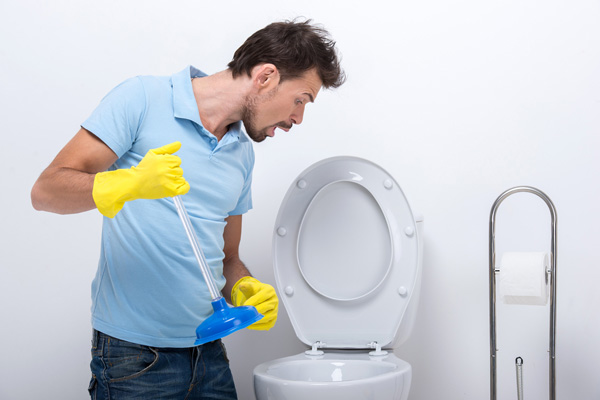We have come across this great article about Here's How to Correctly Use a Toilet Plunger directly below on the net and concluded it made perfect sense to talk about it with you over here.

Introduction
Correct maintenance of household drains pipes is vital for avoiding blockages and making sure smooth water flow. One of the secret tools in every homeowner's toolkit is the plunger, alongside different drain cleansers made to tackle persistent obstructions successfully. This article discovers exactly how to make use of plungers and drain cleansers effectively to keep your drains pipes moving freely.
Section 1: Recognizing Plungers
Types of Plungers
There are a number of kinds of bettors available, each created for various sorts of drains pipes and obstructs. One of the most usual kinds include mug plungers, flange plungers, and accordion plungers.
How Plungers Job
Bettors service the principle of creating stress and suction to remove clogs. When properly used over a drain, they create a vacuum cleaner that can pull out particles or separate clogs.
Choosing the Right Bettor
Selecting the appropriate plunger relies on the type of drainpipe and the nature of the clog. Cup bettors are optimal for sinks and bathtubs, while flange bettors are much better fit for commodes due to their design.
Typical Blunders with Plungers
Preventing these errors ensures efficient plunging: incorrect seal around the drainpipe, inadequate force, and not clearing surrounding particles.
Area 2: Making Use Of Plungers Successfully
Prep work
Prior to diving, guarantee the bettor covers the drainpipe entirely and creates a limited seal. Clear any visible particles around the drainpipe opening.
Strategy
Begin with gentle diving motions to construct suction. Boost stress slowly, using a constant rhythm. Repeat as needed up until the drainpipe clears.
Fixing Tips
If diving doesn't work, attempt readjusting the seal, applying petroleum jelly for a much better seal, or making use of a various type of plunger.
Section 3: Comprehending Drainpipe Cleaning Company
Sorts Of Drainpipe Cleaners
Drain cleansers can be chemical or chemical. Chemical cleansers make use of strong chemicals to dissolve blockages, while chemical cleansers utilize all-natural enzymes to break down raw material.
Just How Drain Cleansers Job
Chemical cleaners react with blockages to liquify them, while enzymatic cleaners break down organic products like hair and oil without damaging pipes.
Safety Considerations
Constantly wear gloves and eye protection when using chemical drainpipe cleansers. Guarantee adequate ventilation and follow manufacturer instructions meticulously.
Eco-Friendly Alternatives
Take into consideration using vinegar and baking soft drink or enzyme-based cleansers for eco-friendly choices that are more secure for pipes and the atmosphere.
Area 4: Using Drain Cleansers Properly
Application Techniques
Pour chemical cleansers straight right into the drainpipe opening. Allow them to benefit the recommended time before flushing with hot water. Enzymatic cleaners ought to sit overnight.
Safety measures
Prevent mixing different types of cleaners, as this can produce toxic fumes. Never utilize chemical cleansers along with a plunger, as spilling can take place.
Handling Stubborn Clogs
For persistent blockages, think about utilizing a plumbing snake or calling an expert plumbing technician to avoid damage to pipes.
Final thought
In conclusion, comprehending exactly how to make use of bettors and drainpipe cleaners effectively is necessary for preserving healthy and balanced pipes systems. By picking the right devices and methods, house owners can tackle small clogs and protect against major pipes issues down the line.
6 Common Drain Cleaning Mistakes and How to Avoid Them
Chemical Meltdown
When you have a blocked drain, one of the first solutions you may think of is to get chemicals to clear it. There are a lot of drain cleaning chemicals on the market and many make huge promises.
However, they often don’t live up to their promises. Depending on the kind of blockage you have, they may only worsen the problem and deepen your frustration.
If you have solids blocking a drain, it’s unlikely that chemicals will be able to clean it effectively. If the chemical is harsh but still cannot dissolve the blockage, then you are stuck with the blockage plus the chemicals inside the drain. Drain cleaning chemicals are toxic and can end up doing more harm than good.
Incorrect Plunging
One of the first drain cleaning tools you will probably reach for when you have a blockage is a plunger. There are several different plungers out there and they’re all made for separate kinds of drains. To get the job done, you need to choose the right plunger for the job.
Sink plungers will have a bell-shaped bottom. Toilet plungers, on the other hand, will have a flat bottom. However, even if you do have the right plunger, you need to make sure that you’re using it correctly.
Place it over the drain and completely seal it off. Push the plunger slowly and precisely, up and down. If you plunge too fast, you may push some of the matter that’s blocking the drain too far down.
Take your time when plunging. It’s understandable that you want to unblock the drain quickly, but plunging too fast can make matters worse.
Poking Into the Drain
After you’ve tried chemicals and even a plunger without much result, you may decide to get creative. But doing this while trying to unblock a drain can go badly.
For example, many people will try to dislodge the blockage by unbending a hanger and sticking it down the drain, but poking at the blockage is never a good idea.
Also, don’t try to use a stick to poke down the drain. It may break, leaving you with bigger problems. More often than not, once a plunger has failed to unblock the drain, poking something down may shove the matter causing the blockage to go further down the drain.
Sticking things down the drain can also put dents and holes into your drain pipe, which could leave you with a costly plumbing bill.
Garden Hosing
When you have a blocked drain outside, you may be tempted to grab your hose and start applying some pressure to try to unblock the drain.
Hydro jetting a blocked drain should be done with equipment that is designed for this purpose.
A garden hose is not the ideal equipment for trying to unblock a drain. The pressure from it will probably not be heavy enough to unblock the drain. This is especially true if the drain is outside and has been blocked by tree roots or even small animals.
Attempting to DIY hydro-jetting can cause flooding which will only make matters worse. It may also cause damage to the pipes.
Incorrect Use of a Drain Snake
A mechanical snake is a great way to unclog a drain. However, it should not be abused.
Do not force the drain snake around pipe corners that are hard to navigate. Using a drain snake too frequently and incorrectly can damage pipes leading to expensive repairs.
Avoiding the Plumber
DIY projects are to be celebrated. We understand that some homeowners would prefer to do repairs themselves to save some money . But there are certain instances where it’s just more cost-effective to call in a professional to deal with the problem.
If you’ve tried everything to unclog your drain and nothing is working, then there’s no need to go any further. It’s time to call a plumber!
https://trusteyman.com/blog/6-common-drain-cleaning-mistakes/

Hopefully you enjoyed reading our part about Tips on How to Effectively Use a Plunger. Thanks a lot for taking the time to read our post. You should set aside a second to promote this post if you liked it. Thanks for your time invested reading it.
Visit Website
 Jennifer Grey Then & Now!
Jennifer Grey Then & Now! Molly Ringwald Then & Now!
Molly Ringwald Then & Now! Gia Lopez Then & Now!
Gia Lopez Then & Now! Katey Sagal Then & Now!
Katey Sagal Then & Now! Robin McGraw Then & Now!
Robin McGraw Then & Now!